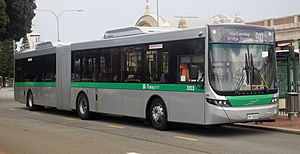Transport in Perth, Western Australia facts for kids
Transport in Perth, Western Australia, is served by various means, among them an extensive highway / freeway network and a substantial system of commuter rail lines and bus routes. Public transport is managed by the Transperth agency.
Contents
History
Following the settlement of the Swan River Colony in 1829, the Swan River was the main transportation link between Perth and the port of Fremantle. Land transportation was difficult as the only river crossing near Perth, a ford at the eastern end of the town, was often impassable for wagons and carts. The next crossing point was 20 miles (32 km) upstream at Guildford, a major detour. The only alternative to these river crossings were ferries, which operated from North Fremantle, Preston Point, and The Narrows.
Public transport
Perth metropolitan public transport, including trains, buses and ferries, are provided by Transperth, with links to rural areas provided by Transwa. Perth provides zero-fare train trips for SmartRider (travel fare card) holders around the city centre (the "Free Transit Zone"), as well as four high-frequency (every 8–15 minutes) Central Area Transit (CAT) bus routes (Red, Blue, Yellow, Green), which, alongside trips on regular Transperth buses in the city centre, are free to all users.
Suburban rail
There are five main rail lines, 70 stations and 15 bus stations in the metropolitan area.
Bus
An extensive bus network services the greater Perth metro area. Many bus routes act as feeder routes to the main rail lines.
Regional and interstate rail
The Indian Pacific passenger rail service connects Perth with Adelaide and Sydney. The Prospector passenger rail service connects Perth with Kalgoorlie via several Wheatbelt towns, while the Australind connects to Bunbury, and the AvonLink connects to Northam.
Trams
Perth's first trams operated for a short period at the end of the nineteenth century, on an unsuccessful horse-car tramway between the GPO and East Perth.
The city's first electric trams began operating in 1899 between East Perth and West Perth, along Hay Street in central Perth. The electric tram network was ultimately expanded west as far as Claremont, north as far as Osborne Park, and south across the Swan River causeway to Victoria Park, Como and Welshpool.
The initial electric tram infrastructure in Perth was privately funded. The government took over the running of trams in 1914, with the aim of better co-ordinating the network. Trams were an integral part of the public transport system in the early 20th century until the advent of the private automobile. However, long term lack of government investment led to the network being phased out by July 1958. A number of Perth's historical trams are maintained at Whiteman Park.
Between 1905 and 1952, Fremantle had a small but comprehensive tramway network of its own. The Fremantle network was owned and operated by a consortium of local municipalities, and was never linked into the Perth network. Throughout its existence, the Fremantle network covered both the Fremantle municipality and the adjacent municipality of East Fremantle. Its tram lines also extended for part of that period into North Fremantle and Melville.
There are now various tourist buses decorated as "trams", but running on rubber tyred wheels independently of rails, in both Perth and Fremantle. They operate services such as the Kings Park tram tour and others.
In 2012 a light rail network, to be known as the Metro Area Express was announced. After being pushed back, it was cancelled in 2016.
Images for kids




